Chapter – 6
Test and Measurement in Sports
In this post, we have given the Important Questions of Class 12 Physical Education Chapter 6 (Test and Measurement in Sports) in English. These Important Questions are useful for the students who are going to appear in class 12 board exams.
| Board | CBSE Board, UP Board, JAC Board, Bihar Board, HBSE Board, UBSE Board, PSEB Board, RBSE Board |
| Textbook | NCERT |
| Class | Class 12 |
| Subject | Physical Education |
| Chapter no. | Chapter 6 |
| Chapter Name | (Test and Measurement in Sports) |
| Category | Class 12 Physical Education Important Questions in English |
| Medium | English |
Very Short Questions
Q.1. What is test?
Ans. Test is a tool, a question set of question an examination which is used to measure a particular characteristic of an indindual or a group of individulas.
OR
Test refers to “any specific instruments, procedure or technique used by starter to dicit from the test taker”.
Q.2. What is measurement?
Ans. According to R.N. Patel
“Measurement is an act or process that involves the assignment of numerical values to whatever is being tested. So it involves the quantity of something.”
Q.3. What do you understand by muscular strength?
Ans. It is the amount of force the muscle or a group of muscles can exert against resistance for short duration as in anaerobic
activitires and aerobic activities.
Q.4. What is Kraus-Weber test?
Ans. Kraus-Weber Test : Kraus-Weber test is composed of six items. It is supposed to measure minimum muscular fitness of an individual.
Q.5. What is motor fitness?
Ans. Motor fitness is a “person’s ability to perform physical activities”.
Q.6. What do you understand by cardiovascular fitness?
Ans. Cardiovascular fitness is the ability of the heart and lungs to supply oxygen-rich blood to the working muscle tissues and the ability of the muscles to use oxygen to produce energy for movement.
Q.7. What do you understand by Harvard step test?
Ans. It is a cardiovascular fitness test. It is good for measurement of fitness and the ability to recover after a strenuous exercise.
Q.8. What is Rockport one mile test?
Ans. It is cardio respiratory test used to deteremine VO2 max. (volume of oxygen) VO2 max is the maximum capacity of the person’s body to move and use oxygen during exercise.
Q.9. What do you understand by flexibility?
Ans. Flexibility is the range of motion in a joint muscler or group of joints, muscler, or, the ability to move joints effectively. Flexibility is related to muscle strength.
Q.10. What do yo understand by senior citizen fitness test?
Ans. Senior citizen fitness test are easy to understand and effective tests to measure aerobic fitness, strength and flexibility using minimum and inexpensive equipments.
Q.11. Why measurement is necessary?
Ans. It is tool which provides information regarding individual’s ability, knowledge, performance and achievement.
Q.12. By which test the one can measure abdominal strength?
Ans. Kraus-Weber test Abdominal pluse and minus psoas muscler.
Q.13. Write the slaughter & lohmarn children skin foid formulae to calculate the fat percentage in boys & girls.
Ans. Slaughter– lohman children skin fold formula
fat % (boys) = 0.735 + (sum of skin fold) + 1.0
fat % (girls) = 0.610 + (sum of skin fold ) + 5.0
Q.14. To calculate the fitness index of an individual?
Ans.

Q.15. Calculate body fat % of boy aged 16 years whose measurement of skin fold tricep’s 14 mm and calf is 11 mm. By using slaughter & lohman’s formula?
Ans. Slaughter Lohman’s fat % of formula = (0.735 × (sum of skin fold) + 1.0
= 0.735 × (14 + 11) + 10
= (0.735 × 25) + 1.0
= 18.375 + 1.0
= 19.375
Short Answer Questions (3 words)
Q.1 Explain the Rock port one mile test’s Administration?
Ans. It is also known as Rock port fitness walking test. Its objective is to check or observe the development of the individual VO2 max, (maximum volume of oxygen.)
Administration of Rockport Fitness Walking Test :
The athlete is asked to start the mile long walk and complete it as quikckly as possible. The athlete has to bear in mind that She/he does not start running or jogging in an effort to complete the test. Once the athlete has completed walking the mile, the time taken to do so is recorded in minutes and hundreds of seconds and the heart rate is recorded as beats per minute. After the time and heart rate are recorded,
The following variables are also recorded :
- Age in years
- Gender (women are given a value of 0 and men a value of 1)
- Time to complete the one mile walk (in minutes and hundreds of seconds.)
- Heart rate in beats per minute (recorded immediately after stoppoing)
The following formula is used to calculate the score for this test :
![]()
Q.2. Discuss the Back Scratch test for upper body flexibility.
Ans.
Back Scratch Test : Purpose :- To assess the upper body (shoulder) flexibility, which is important in performing various jobs such as combing one’s hair, putting on overhead garments and reaching for a seat belt etc.
Equipment Required:- A ruler.
Procedure:- This test is performed in standing position. Keep one hand behind the head and back over the shoulder and reach as far as possible
down middle of the back. Plams should touch to body and the fingers should be downwards. Then carry other arm behind back palm facing outward and fingers upward and reach up as far as possible trying to touch or overlap the middle fingers of both hands. Fingers should be aligned. Measure the distance between the tips of the fingers. If the finger tips touch then the score is zero. If they do not touch measure the distance between the fingertips (–ve score). If they overlap measure by how much (+ive score). Practise two times and then test

Q.3 Explain the chair stand test for lower body strength.
Ans.
Chair Stand Test: Purpose. The main purpose of this test is to measure the lower body strength, particularly legs strength which is usually required for various tasks such as climbing stairs, getting in and out of vehicle, bath tub or chair.
Equipment Required: A chair with a straight back and a seat of at least 44 cm and a stopwatch.
Instructions for Participants.
- The participant should sit in the middle of the chair.
- She/He should keep his hands on the opposite shoulder crossed at the wrists.
- The feet should be flat on the floor.
- Her/His back should be erect.
- Repeat sit up and down for 30 seconds.
Procedure: Keep the chair against the wall. The participant sits in the middle of the seat. His/her feet should be shoulder width apart and flat on the floor. The arms should be crossed at the wrists and held close to the chest. From the sitting position, the participant stands up completely then back down at the start of the signal. This is repeated for 30 seconds. Count the total number of complete chair stands. In case the participant has completed a full stand from the sitting position when the time is finished the final stand is counted in the total.
Q.4. Write the test to measure the aerobic fitness of serious infirm?
Ans. Rikli & Jone’s Test- Senior citizen’s test.
6 Minutes Walk Test is used for aerobic fitness.
Purpose: This test measures aerobic fitness of senior citizens.
Equipment required: Measuring tap to mark out the track distances, stopwatch, chairs positioned for resting.
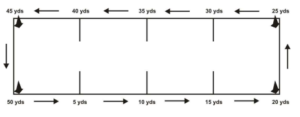
Procedure :
- The walking course is laid out in a 50 yard (45.72m) rectangular area (dimensions 45 × 5 yards), with cones placed at regular intervals to indicate distance walked.
- The aim of this test is to walk as quickly as possible for six minutes to cover as much distance as possible.
- Subjects are set their own pace (a preliminary trials is useful to practice pacing), and are able to stop for a rest if they desire.
Q.5. Discuss the test item of Rikli & Jones to measure the upper body strength?
Ans. Arm Curl test of Rikli & Jones used to Testing upper body strength of senior citizen
Equipment: 5 lb Weight & an 8 lb weight, stopwatch & a straight-back chair with no arms. Women will curl a 5 lb. weight in this test and men will curl a 8 lb. weight for their test. It is extremely important to the accuracy of the test that we use the appropriate weight for men & women in this test.

Procedure :
- The test assistant will tell to begin and will time for 30 seconds, using the stopwatch or a watch with a second hand.
- Do as many curls as can in the allotted30-second time period, moving in a controlled manner.
- Do a full curl, squeezing the lower arm against the upper arm at the top of each curl and returning to a straight arm each time. Keep upper arm still.
- Do not swing the Weight.
- If started raising the weight again and are over halfway up when time is over, count that curl!
- Scoring: The score is the total number of controlled arm curls performed in 30 seconds.
Q.6. Which Test is used to measure the coordination and Agility of senior citizen. Write in detail?
Ans. Eight Foot up and Go Test:- Rekli & Jones Senior Citizen
Test: This test is a coordiantion and agility test for senior citizens.
Purpose: To assess speed, agility and balance while moving. These are important in perfoming various jobs which require quick manoeuvring, such as getting of a bus in time and to answer the phone etc.
Equipments Required: A chair with straight back (about 44 cm high) a stopwatch, cone marker, measuring tape and an area without any hindrances.
Procedure : Keep a chair next to the wall and the marked, 8 feet in front of the chair. The participant starts completely seated, hands resting on the knees and feet flat on the ground. On the command ‘Go’’ stopwatch is started and the participant stands and walks (no running at all) as quickly as possible to and around cone and returns to the chair to sit down. Time is noted as She/he sits down on the chair. Two trials are given to the participant.

Q.7. Discuss Chair Sit and Reach Test in briefly?
Ans. Chair Sit and Reach Test
Daily Benefit: Lower body flexibility is important for preventing lower back pain. It also plays a role in balance, posture, in fall prevention, or walking. Lower body flexibility is important for maintaining an active, independent lifestyle.
Purpose: This test measures lower body flexibility.
Equipment required: Ruler, straight back or folding chair, (about 17 inches/ 44 cm high)

Procedure :
- The suobject sit on the edge a chair (placed against a wall for safety).
- One foot must remain flat on the floor. The other leg is extended forward with the knee straight, heel on the floor, and ankle bent at 90°.
- Place one hand on top of the other with tips of the middle fingers even. Instruct the subject to inhale, and then as they exhale, reach forward toward the toes by bending at the hip.
- Keep the back straight and head up. Avoid bouncing or quick movements, and never stretch to the point of pain. Keep the knee straight, and hold the reach for 2 seconds.
- The distance is measured between the tip of the fingertips and the toes.
- If the fingertips touch the toes then the score is zero. If they do not touch, measure the distance between the fingers and the toes (a negative score). If they overlap, the measure by how much (a positive score).
- Perform two trials.
Q.8. Explain General Motor Fitness Test?
Ans. General Motor Fitness Test :
Barrow’s Three-items General Motor Ability Test
Motor abilities play a very vital role in achieving apex position in games and sports. Motor fitness invovles speed, agility, power, coordination, strength and so on. These components of fitness are necessary for competing at top levels. For measuring general motor fitness, the three-item test battery of Barrow is used. In this test, battery of three items such as standing broad jump, zig-zag run and medicine ball throw are used to measure the general motor ability of an individual. The details of administration of these tests are described below :
1. Standing Broad Jump (for measuring leg strength)
Equipment and material: A mat of 5 × 12 feet and a measuring taps, if the mat is unmarked.
Procedure: A take-off line is marked on the ground. Subject stands just behind the take-off line with the feet several inches apart. The subject swings the arms and bends the kneers to take a jump in the long jump pit. Three trials are given to the subject. The distance is measured from the take-off line to the heel or other part of body that touches the ground nearest to the take-off line. All jumps are measured and the best one is recorded.

2. Zig-Zag Run (for measuring agility and speed)
Equipment and material: Stopwatch, five obstacles, and space enough to accommodate the 16 × 10 feet course.
Procedure: The subject begins from a standing start on the command to run. The subject runs the prescribed pattern stated to him as quickly as he can without gasping. Three complete circuits are run. The stopwatch is started when the command to run is given and stopped immediately when the subject crosses the finish line. The time is recorded to the nearest tenth of a second. Before running the zig& zag run, the subject should warm up properly. The subject should wear proper fitting shoes with good traction to avoid blisters and slipping. Demonstration of the pattern of the course should be given by the administrator before the beginning of the run.

3. Medicine Ball Put (for measuring arm and shoulder strength)
Equipment and material: A medicine ball and measuring taps.
Procedure: The subject stands between two restraining lines which are 16 feet apart. In case of girls, a medicine ball of 1 kg is provided, whereas in case of boys a medicine ball of 3 kg is provided to be put. After that he/she asttempts to put the medicine ball out as far as possible without crossing the restraining line. He/she should hold the medicine ball at the junction of the neck and shoulder then the ball should be put
straight down the course. Three trials are given to him/her. The best of three trials is recorded. The distance is computed to the nearest foot. A put in which the subject comnits a foul is not scored. However, if all the trials are fouls, subject he/she should try until he/she make a fair put.

Q.9. The duration of a runner to run 30 seconds. The of heart beats in 1-1/2, 2-2 & 3-3 minutes 85, 75 and 60 respectively of calculate physical fitness index for the runner?
Ans.
According to Harvard step test,
Physical fitness Index of runner
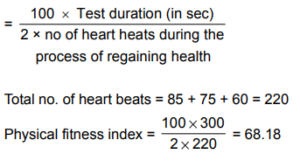
(Long Answer Type Question (5 marks each)
Q.1. Describe the procedure of the components of Kraus-Weber Test?
Ans. Kraus-Weber Test
Dr. Hans Kraus and Dr. Sonja Weber developed the KrausWeber Minimum muscular strength Test in the 1950’s. The six-items medical fitness test measures the strength and flexibility of key postural (core) muscles. The test consists of five strength challenges and one general flexibility procedure.
Administration of the Kraus-Weber Test
The following six tests of key muscle groups represent the minimal performance necessary for healthy living. Because this is a minimum test, you will need to be able to perform All six parts successfully.
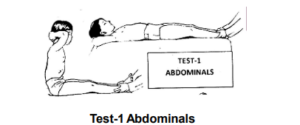
Test-1 : Purpose : To measure the flexibility of the lower back and hamstring muscles.
Procedure : The subject lies down in supine position i.e… flat on his back and hands behind his neck. The legs are straight. The examiner holds the feet to keep them on the ground. The subject is asked to perform one sit-up.
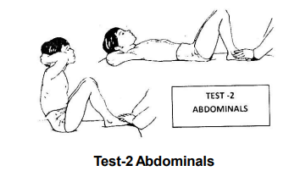
Test-2 Purpose : to assess the strength of the abdominal muscles.
Procedure : The subject lies down in a supine position flat on his back and hands behind his neck except that this time the knees are bent. The examiner holds the feet to keep them on the ground. The subject is required to perform one sit-up.
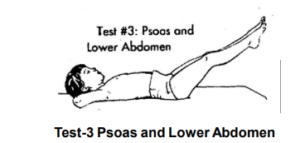
Test-3 Purpose : to assess the strength of the psoas and lower abdominal muscles.
Procedure : Subject lies in supine position i.e., flat on his back with his hands behind the neck. He is asked to raise his feet 25 cm (10 inches) from the ground. His legs should be straight, no bending at the knee.

Test-4 Purpose : to assess the strength of the upper back muscles.
Procedure : The subject lies in prone position i.e… face down on his stomach with a pillow under his lower abdomen and his hands behind his neck. The examiner holds his feet down. The subject is asked to raise his chest, head and shoulders, while the examiner counts to 10 seconds.

Test-5 Purpose : to assess the strength of the lower back muscles.
Procedure : The subject lies in prone position i.e… face down on his stomach with a pillow under this lower abdomen and his hands behind his neck. The examiner holds his chest down. The subject is asked to raise his feet, keeping his knees straight. The examiner counts to 10 seconds.

Test-6 Purpose : To measures the flexibility of the lower back and hamstring muscles.
Procedure : The subject stands erect, bare-footed, hands at sides and feet together. He is asked to lean down slowly to touch the floor with finger-tips for 10 second. Bouncing and jerking is not allowed. The examiner holds his knees in order to prevent any bending.
Q.2. Explain the Administration of AAPHER Youth Fitness Test?
Ans. Motor Fitness Test AAHPER (American Alliance for Health, Physical Education and Recreation)
Motor fitness refers to the capability of an athlete to perform effectively at their particular sports. The components of motor fitness are agility, balance, co-ordination, which entails speed and strength and finally reaction time. The following items were included in AAPHER youth fitness
test battery.
- Pull-ups for boys & flexed arm hand for girls.
- Flexed-let sit-ups
- Shuttle run
- Standing long jump
- 50 yards dash
- 600 yards run/walk
A. Pull-ups for boys

Purpose : To measure arm and shoulder strength.
Equipment : A metal or wooden bar approximately 1½ inches in diameter is preferred. A doorway gym bar can be used and if no regular equipment is available,a piece of pipe or even rungs of a ladder can serve the purpose.
Procedure : The bar should be high enough so that the student can hang with his arms and legs fully extended and feet free from the floor. The bar is held with palm facing away from his. The student is advised to raise body so that the chin reaches the level of bar. Then he/she lowers his body to a full hang as in starting position. The exercise is repeated as many times as possible.
Rules :
(i) Each student will be allowed one trial.
(ii) The body must not swing during the execution of the movement.
(iii) The knees must not be raised and the kicking of legs is not permitted.
Scoring : Record the number of completed pull ups.
B. Flexed arm hang for girls

Purpose : To measure arm and shoulder strength.
Equipment : A horizontal bar is used. The diameter of the rod to be 1½ inches. A stop watch is needed to record time.
Procedure : The height of the bar should be adjusted so it is approximately equal to the pupil’s. standing height. The pupil should use an overhang gaps, with the assistance of two supporters, one in front and one in back. The Pupil raises her body off the floor to a position where the Chin is above the bar, the elbows are flexed and the chest is close to the bar. The pupil holds this position as long as possible.
Rules :
1. The stopwatch to start as soon as the subject takes the hanging position.
2. The watch is stopped when.
(i) Pupil’s Chin touches the bar
(ii) Pupil’s head hits back ward to keep Chin above the bar.
(iii) Pupil’s Chin falls below the level of the bar.
2. Flexed-leg sit-ups

Purpose : To measure abdominal strength and endurance.
Equipment : clean floor, mat or dry turf & stop watch
Procedure : The student is advised to lie on floor on his/her back. keeping knees bent. The angle of knees should be around 90 degree. The feet are held by partner. The student is further advised to put fingers interlocked and put behind the head. The student curls up and touches the elbows to knees.
Score : The score is counted as maximum number of sit ups in 60 seconds.
3. Shuttle run
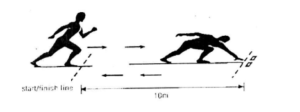
Purpose : To measure speed and agility.
Equipment : 1. Two wooden block 2 × 4 inches 2. Stop watch
Procedure : Two parallel lines are marked 30 feet (10 mts) apart wooden blocks 2 × 4 inches are kept on one side of marked line. The student stands opposite to the line, where wooden blocks are placed. On start the student runs towards wooden blocks and pick one of them. Then places the block on the line from where he started. The student continues to run and similarly lift other block and place at starting line.
Score : The score is each lap time for complete trial. The better of two trials is taken as final score.
4. Standing long Jump
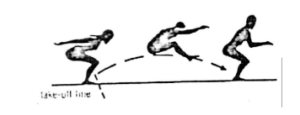
Purpose : To measure legs power.
Equipment : Mat, Floor or outdoor jumping pit & measuring taps.
Procedure : The student is advised to stand on restraining line with feet close and he/she dips at the knee swinging arms before jumping. The student lands on both feet together. The distance from take off line to the heel is measured in inches.
Score : The best of three trails is recorded as final score.
5. 50 yards dash
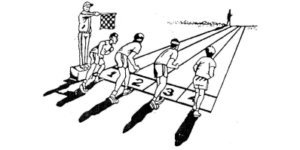
Purpose : To meassure speed
Equipment : 50 yards marked track, stop watch
Procedure : pupils will take positions behind the starting line. The starter will give the start and the time keeper on finish will
take the time on starter’s signal.
Score : The score is the amount of time between the starter’s signal and instant the pupil crosses the finish line. The time is recorded nearest to 10th of a second.
6. 600 Yards run (548.64 Meters)
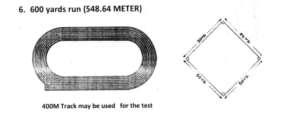
Equipment : marked track, stop-watch
Procedure : Pupil will take standing start from starting line. On starter’s signal they will start running. The pupils are advised to run or walk for 600 yards but the aim is to finish as early as possible.
Q.3. Explain harvard Step Test in details?
Ans.
Harvard Step Test : The harvard step test is a test of aerobic fitness, developed by Brouha et al. (1943).
Objective : The objective of this test to monitor the development of the athlete’s cardiovascular system.
Required Resources :-
- Gym bench (45 cm high)
- Stopwatch
- Assistant

How to Conduct the test
This test requires the athlete to step up and down off a 45 cm high gym bench for 5 minutes at a rate 30 steps/minute.
- The athlete warm up for 10 minutes
- The assistant gives the command “Go” and starts the stopwatch.
- The athlete steps up-up and down-down onto a standard gym bench once every two seconds for five minutes (150 steps)
- The assistant stops the test after 5 minutes.
- The assistant measures the athlete’s heart beat rate (bpm) one minute after finishing the test pulse 1
- The assistant measures the athlete’s rate (bpm) two minutes after finishing the test – Pulse-2
- The assitant measure the althlete’s heart rate (bpm) three minutes after finishign the test pulse 3.
Fitness Index physical efficiency Index

We hope that Class 12 Physical Education Chapter 6 (Test and Measurement in Sports) Important Questions in English helped you. If you have any queries about class 12 Physical Education Chapter 6 (Test and Measurement in Sports) Important Questions in English or about any other notes of class 12 Physical Education in English, so you can comment below. We will reach you as soon as possible…